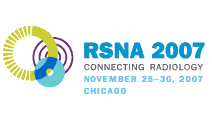
Abstract Archives of the RSNA, 2007
Christopher Laperle PhD, Presenter: Nothing to Disclose
Philip Wintermeyer, Abstract Co-Author: Nothing to Disclose
Daxin Shi PhD, Abstract Co-Author: Nothing to Disclose
Mark Anthony Anastasio MSEE, Abstract Co-Author: Nothing to Disclose
Christoph Rose-Petruck PhD, Abstract Co-Author: Nothing to Disclose
Gerald Diebold PhD, Abstract Co-Author: Nothing to Disclose
Jack Wands MD, Abstract Co-Author: Nothing to Disclose
et al, Abstract Co-Author: Nothing to Disclose
et al, Abstract Co-Author: Nothing to Disclose
To develop high-resolution imaging of microvasculature in excised murine liver samples using x-ray phase contrast imaging and concurrently couple computed tomography to the technique.
All mice used in this study were housed and cared for in accordance with NIH guidelines. Images of excised and fixed whole murine liver samples were taken using a microfocus x-ray tube (Oxford, Inc. Model UM-M1), and a thermoelectrically cooled CCD camera with 16 million pixels designed specifically for x-ray detection (PI/Acton PI-SCX). The magnification was approximately 4x and exposure time was typically 3 minutes while running the x-ray tube at 90keV and 10W. In tomographic scans, the sample was rotated and similarly imaged in one-degree increments through 360 degrees. An FDK reconstruction algorithm was applied to compute the tomographic image slices.
Images of the whole liver including nearly 100% of the microvasculature structure resolved down to 15μm were obtained. The high-resolution observed was attributed to phase-contrast features arising from the density gradients in the x-ray beam path at the interfaces between the vessels and soft tissue of the liver. The tomographic reconstruction algorithm adequately revealed the microvessel structure and allowed for three-dimensional visualization of the sample.
X-ray phase-contrast imaging coupled with computed tomography provides high-resolution visualization of the microvessel structure of whole excised mouse liver tissues. Application of the technique to image neovascularization associated with tumor proliferation in a murine model of heptacelluar carcinoma are underway.
The imaging technique is viable for visualizing microvasculature with high-resolution in ex vivo liver samples without destruction of the sample or the use of a contrast agent.
Laperle, C,
Wintermeyer, P,
Shi, D,
Anastasio, M,
Rose-Petruck, C,
Diebold, G,
Wands, J,
et al, ,
et al, ,
High-Resolution X-ray Phase Contrast Imaging and Coupled Computed Tomography of Excised Murine Liver Samples. Radiological Society of North America 2007 Scientific Assembly and Annual Meeting, November 25 - November 30, 2007 ,Chicago IL.
http://archive.rsna.org/2007/5001561.html

